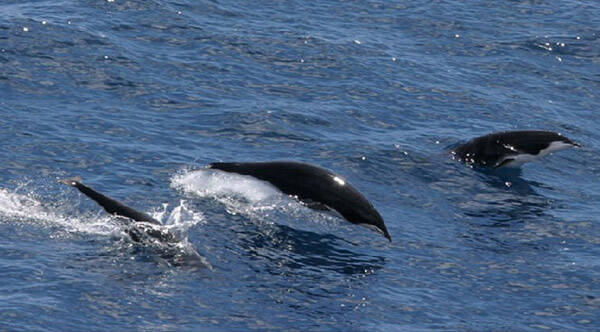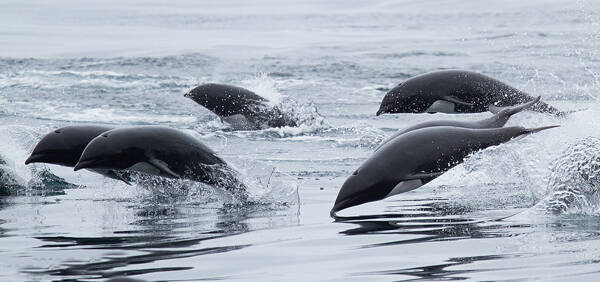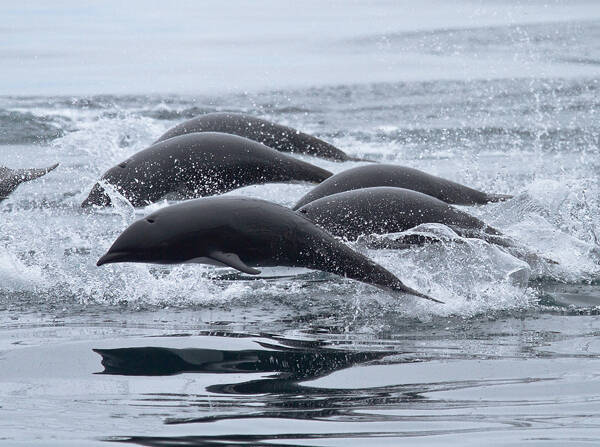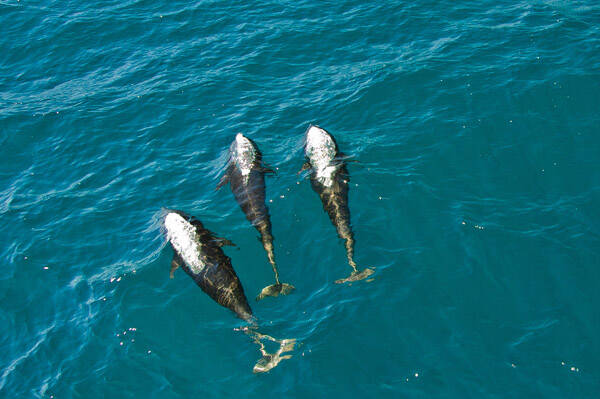Lissodelphis borealis
IUCN
LCBasic Information
Scientific classification
- name:Lissodelphis borealis
- Scientific Name:Northern whale dolphin, warm water finless beaked dolphin
- Outline:Cetacea
- Family:Delphinidae R.dolphin
Vital signs
- length:211.2-307cm
- Weight:About 115kg
- lifetime:About 40 years
Feature
The body is slender, tapering towards the tail like an eel, and the whole body is generally black with a white belly.
Distribution and Habitat
Distributed in the temperate deep waters of the North Pacific, approximately between 30° and 50° north latitude.
Origin (sea area): Canada, Japan, Mexico, Russia, and the United States.
The northern right dolphin mainly inhabits the deep waters of the continental shelf and occasionally appears in coastal waters (especially the deep waters created by the coastal seabed environment). It likes to move in cold water, and the suitable water temperature is generally 7.8~18.9℃.
Appearance
The lower jaw is longer than the upper jaw. There is a white patch behind the tip of the lower jaw. The beak is narrow and short, with a distinct groove between the beak and the forehead. The head is narrow. The forehead is gently sloping. The pectoral fins are small and slender, with sharp ends. The white chest color extends to the tail fin in a linear shape (there are individual differences), and the boundary between the black and white parts is obvious; the white band at the navel is larger in males. There is no dorsal fin. The back and sides of the body are black, sometimes with a brown sheen. The tail shaft is narrow. The tail fin is narrow, the ventral surface of the tail fin is mainly white, the end is sharp, and the outer edge is concave inward; the center of the tail fin is obviously notched.
The number and tooth type of teeth vary greatly between individuals of this species, usually 37-52/42-54 conical teeth on each side of the upper and lower jaws, and the total number of
Details
Northern right whale dolphin (scientific name: Lissodelphis borealis) is called Northern right whale dolphin in foreign language, and has no subspecies.

When the northern right dolphin swims and jumps quickly, the overall impression given is that of a leap; each leap can reach up to 7 meters. Very easily startled. When fleeing, the entire group will gather together, and then many individuals will leap at the same time, making the sea surface foamy. When startled or just swimming quickly, a group of northern right dolphins will take a long, shallow leap; usually re-enter the water cleanly and gracefully, occasionally re-entering the water by belly-strike or side-strike when fleeing danger. They may also swim slowly, with almost no waves (probably because they have no dorsal fin), with only a small part of their body above the water.
It is common for northern right dolphins to leap, belly-strike, side-strike, and tail-strike. They may ride the waves with their bows, but usually avoid ships. They swim very fast, up to 34 km/h. The breathing interval is 10-75 seconds.
Northern right dolphins migrate southward and close to the coast in the winter and northward and away from the coast in the summer. In the eastern part of their range, especially in California, they have been found to leave the coast in the fall and increase their frequency of shore visits until the winter solstice. As temperatures gradually warm, northern right dolphins decrease their frequency of shore visits in late spring and early summer. In the western part of their range, such as the waters off northern Honshu, they are only seen outside of the summer, and the reason for their migration is unknown; changes in water temperature may be a factor. In the fall, northern right dolphins swim to the cold waters of the California coast, and away in the spring and summer. Another factor affecting their migration may be related to the abundance of food. In California, the maximum number of northern right dolphins is correlated with the maximum number of their main prey species.

Northern right dolphins are highly social species and usually live in groups. The average size of the group along the eastern Pacific coast is 110; the average size along the western Pacific coast is 200. Occasionally, there will be solitary individuals that do not form a group. The maximum diving time of the entire group can reach 6.15 minutes. There are four different types of groups: a tightly knit group with no distinct subgroups; a loose group of subgroups; a V-shaped formation; and a line of members. Northern right dolphins use the first type of grouping when they are with other cetaceans. They also form mixed groups with Pacific spotted dolphins. The most common contact for northern right dolphins is with Pacific spotted dolphins, but other contacts include bottlenose dolphins, short-beaked dolphins, striped dolphins, Richter's dolphins, white-rumped porpoises, short-finned pilot whales, fin whales, sei whales, humpback whales, gray whales, and California sea lions.
All records of northern right dolphins stranding are of individual individuals, not groups. There are usually a few strandings each year, but there are exceptions, such as in 1981, when about 23 northern right dolphins stranded on beaches in central and southern California for unknown reasons. The main cause of cetacean strandings may be related to pain caused by disease or parasites.
Northern right dolphins mainly communicate with "clicks" or pulses, unlike other dolphin species, they do not whistle (whistle). A common sound is a series of short pulses, containing 6 to 18 short pulse units. Eight unique short pulse series have been recorded, but most other short pulse series are just repetitions of the sequence. Compared with the "click" sound of echolocation, the short pulse sound is lower in frequency and shorter in duration. The short pulse sound may play a similar role in communication as the whistle sound commonly used by other dolphin species.

The northern right dolphin mainly feeds on mid-ocean fish and squid, diving to 200 meters below the water surface to find food. Through the examination of stomach samples of two northern right dolphins, it was found that fish accounted for 89% of the stomach contents, among which lantern fish (Myctophidae) accounted for 89% of all fish food, and the most common ones were Lampanyctus jordani and Ceratoscopelus warmingi; squid accounted for about 11% of the stomach contents (Chou et al. 1995). Walker and Coe (1989) examined two stomach samples of northern right dolphins from Santa Monica and Los Angeles and found marine plant leaves, bees, white bird feathers, small pieces of plastic bags, several pieces of blue polyethylene plastic and a rusty metal bottle cap.
The minimum birth interval of northern right dolphins is about 2 years, during which the gestation period of female dolphins exceeds 1 year (12.1~12.3 months), and the ovarian activity of female whales that gave birth 1 year ago is still lacking (difficult to get pregnant). The peak breeding season is in July and August. The average length of newborn dolphins is estimated to be 99.7~103.8 cm (Ferrero & Walker 1993). The lactation period is unknown. The average age of sexual maturity of females is 9.7~10.4 years old, that is, the body length reaches 199.8~201.1 cm. The average age of sexual maturity of males is 9.9~10.1 years old. Before sexual maturity, the size of male testicles changes little with age, but after sexual maturity, it grows rapidly and the mass can reach 117.4~1,300 grams.

Valid population data for the northern right dolphin are limited to a small area. Buckland et al. (1993) estimated 68,000 (CV=71%) in the North Pacific, Miyashita (1993) 307,000, and Hiramatsu (1993) estimated 400,000 for the same area based on bycatch. All of the above estimates are highly uncertain, and Buckland (1993) considered the two highest estimates to be positively skewed. In the eastern North Pacific, the population of the northern right dolphin varies seasonally. The abundance of the population along the west coast of the United States ranges from 9,000 to 21,000 individuals (Forney 1995, Barlow & Forney), and the average abundance in the area from 1996 to 2001 was about 11,000 (CV=26%) (Barlow & Forney). The natural enemies of the northern right dolphin are unknown, but they may be killer whales and large sharks.
Listed in Appendix II of the Convention on the Conservation of Migratory Species of Wild Animals (CMS).
Listed in Appendix II of the Convention on International Trade in Endangered Species of Wild Fauna and Flora (CITES).
Listed in the IUCN Red List of Threatened Species: Least Concern (LC), assessed in 2008.
Listed in China's National List of Key Protected Wildlife: National Class II Protected Animal (effective December 10, 1988, Cetacean*Other Cetaceans).
Protect wildlife and stop eating game.
Maintaining ecological balance is everyone's responsibility!








